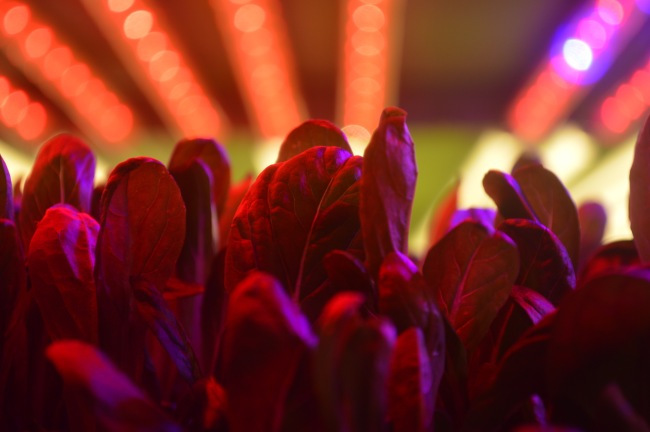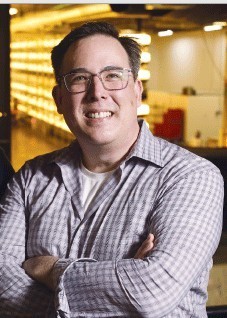[INTERVIEW] Vertical farming: Growing greens in the air
By KH디지털2Published : Sept. 15, 2016 - 00:01
[THE INVESTOR] Forget sunshine and soil to grow leafy greens and fresh vegetables for health-conscious consumers. A US venture firm is leading a new wave of future agriculture by adopting the latest technology to produce something fresher, safer and more environmentally conscious at the heart of urban spaces.
Instead of growing crops on land with the use of pesticides and water, Newark-based AeroFarms is running high-tech greenhouses to produce high quantities of nutritious and quality fresh food all year round. Indoor vertical farming -- a concept invented by Dickson Despommier, an ecologist and emeritus professor at New York City’s Columbia University -- is what the firm has been promoting.
The firm grows massive amounts of edible greens in stacked rows that reach to the ceiling in a controlled environment where the temperature, nutrients and lighting are constantly monitored and adjusted. At AeroFarms, plants grow under light-emitting diodes on permeable micro fleece cloth irrigated with a nutrient-infused mist. It uses 95 percent less water, about 50 percent less fertilizers and zero pesticides.
Instead of growing crops on land with the use of pesticides and water, Newark-based AeroFarms is running high-tech greenhouses to produce high quantities of nutritious and quality fresh food all year round. Indoor vertical farming -- a concept invented by Dickson Despommier, an ecologist and emeritus professor at New York City’s Columbia University -- is what the firm has been promoting.
The firm grows massive amounts of edible greens in stacked rows that reach to the ceiling in a controlled environment where the temperature, nutrients and lighting are constantly monitored and adjusted. At AeroFarms, plants grow under light-emitting diodes on permeable micro fleece cloth irrigated with a nutrient-infused mist. It uses 95 percent less water, about 50 percent less fertilizers and zero pesticides.

The US firm is also working on turning an old steel mill in Newark, New Jersey into the world’s largest indoor vertical farm.
In the 6,503-square-meter space, the firm aims to produce over 900,000 kilograms of baby greens per year, said Marc Oshima, the co-founder and chief marketing officer of AeroFarms in an email interview with The Korea Herald.
Indoor farming can ease growing concerns about climate change, population growth and fast urbanization, he said. Not only is vertical farming sustainable and socially responsible, it is a promising business as it produces greens that are tasty, rich and more nutritious, he added.
Vertical farming, in particular, can be a solution for tech-savvy South Korea that has millions of people living in congested city areas, as it offers a greater level of control to consistently grow high quality food, he said. Korean municipalities have been investing in local startups to conduct research and development into indoor farming. But there have not been many local companies involved in such business so far, according to local experts, citing the lack of economic feasibility and efforts in securing the market.
Oshima answered questions in an interview with The Korea Herald.
1. What inspired you to start a high-tech farming business?
We are committed to building, owning and operating indoor vertical farms that grow delicious, safe, healthy food in a sustainable and socially responsible way all over the world.
We build our farms in repurposed spaces benefitting communities and creating local jobs. Our R&D facility was once a night club and one of our farms is a former paintball/laser tag arena. We are currently building the world’s largest indoor vertical farm in an old steel mill in Newark, New Jersey. It will be 70,000 square feet (6,503 square meters) and have capacity of up to 2 million pounds (907,184 kilograms) of produce per year.
2. What are the benefits of vertical farming for customers, businesses and communities?
Our way of farming mitigates food safety risks: no soil, completely insulated from neighboring operations, no pesticides ever, and we can track a package of greens down to the exact square foot of growing. Most of the common food safety risks simply are not an issue with our system. In addition, all of our farmers and staff go through rigorous food safety training, and we are certified with the United States Department of Agriculture Good Agricultural Practices.
Food-borne illnesses from vegetables are mainly a product of the practices needed to sustain large-scale commercial agriculture. Overuse of antibiotics in factory farming of livestock has created resistant bacteria, which are then sold to farmers in the form of manure or fertilizer.
Also, all of our farms have been in repurposed spaces. Our technology can really fit anywhere, but we have been focusing on dormant warehouse space that is close to existing retailers and food service distributors. A big part of our mission is to decrease food miles and travel time so that our greens are as fresh as possible when you eat them. That is why we focus on urban warehouse space specifically. But also, it’s gratifying to breathe some new life into areas that may have lost manufacturing businesses decades ago. The communities we enter are so ready for us to come in and start growing and hiring.

3. What differentiates AeroFarms’ greens from other greens produced through conventional farming methods and mass production?
Just because the supermarket shelves are stocked doesn’t mean that all is well. Food in the US travels thousands of miles and is often up to two weeks old when it reaches consumers.
That’s why distribution is a huge part of our thought process when opening new facilities. AeroFarms builds farms on major routes and near distribution centers so that our greens spend minimal time in transit. That means longer shelf life, less shrink, better taste and also better nutrition. The second a leaf is harvested the nutrition starts to degrade, so when we can cut transit time down by growing locally we give consumers an even healthier product.
So not only do our greens reach the store with more of their original nutrition, our precise control of every aspect of the nutrients, water and environment our plants use to grow means we can create the perfect conditions to optimize for flavor, taste, color, and yield to have a truly sustainable business. Our products are available to the consumer at the exact same price as field-grown produce, while delivering superior value.
4. Will high-tech vertical farming be the future of farming?
Vertical farming is growing as quickly as it is because the relief of pressure on our natural resources currently caused by industrial farming is striking a chord. Traditional farming will always be an important part of the food supply, but we would like to see vertical farming become a substantial percentage of overall production. From a food security point of view it’s just smart -- but also from a biodiversity and flavor point of view.
5. Who does your business mainly target?
Our greens are incredibly tasty and tend to convert even people who don’t think they like to eat leafy greens -- so there’s really no one in America who is not a potential customer. Our goal is to democratize access to good, healthy food that is responsibly grown.
6. Do you think that vertical farming could be a good business opportunity in Korea?
Absolutely. Vertical farming is a great solution for dense urban areas because fresh food often has to travel long distances from rural areas to these cities. More importantly, vertical farming offers a far greater level of control to be able to consistently high quality food.

7. What are the challenges you have faced so far? Has there been any opposition from local farmers?
The biggest challenge for us so far has been getting to market fast enough. We have more demand from retailers than we can supply, which is why we’re working hard to bring new farms online as quickly as possible. We don’t really see ourselves in competition with local farmers. What we’re looking to disrupt is the giant industrial farms in California and Arizona, which have energy and water needs that are vast and generally unreported. Plus, with 20 crop turns a year, we can provide fresh local greens in February, when we’re really not competing with anyone.
8. What kind of advice do you have for Korean startups or government-funded entities interested in vertical farming?
Growing indoors is not easy to do and we really want to underscore the importance of food safety. At the end, we recommend that experts like AeroFarms get engaged to help in the process.
9. What are your future strategies?
We are looking to build 25 farms over the next five years, and that is a very conservative number given the demand. We currently have farms in development on four different continents, including Asia.
By Cho Chung-un/The Korea Herald (christory@heraldcorp.com)








![[Today’s K-pop] BTS pop-up event to come to Seoul](http://res.heraldm.com/phpwas/restmb_idxmake.php?idx=644&simg=/content/image/2024/04/17/20240417050734_0.jpg&u=)
![[Graphic News] More Koreans say they plan long-distance trips this year](http://res.heraldm.com/phpwas/restmb_idxmake.php?idx=644&simg=/content/image/2024/04/17/20240417050828_0.gif&u=)






![[KH Explains] Hyundai's full hybrid edge to pay off amid slow transition to pure EVs](http://res.heraldm.com/phpwas/restmb_idxmake.php?idx=652&simg=/content/image/2024/04/18/20240418050645_0.jpg&u=20240419100350)

